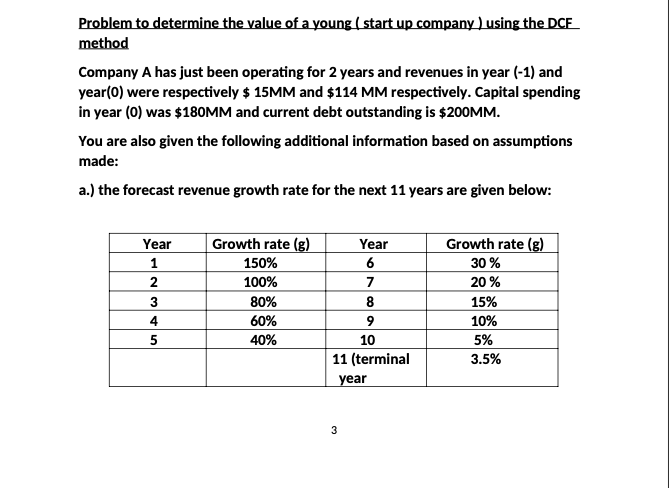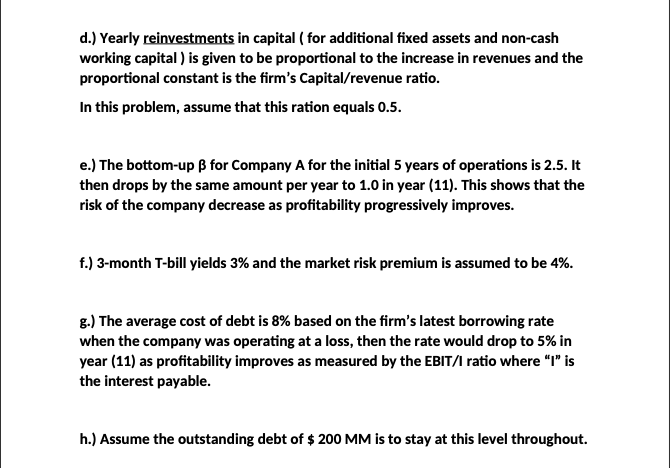Answered step by step
Verified Expert Solution
Question
1 Approved Answer
Assumptions we've made: depreciation rate is 4%. net working capital to be 10% of sales from year 1 to 10. net working capital to increase



Assumptions we've made: depreciation rate is 4%. net working capital to be 10% of sales from year 1 to 10.
net working capital to increase to 11% of sales on year 11.
the market value of equity is equal to of the market value of the total assets, liability being , we would assume the total assets to be worth 200x4= 800 million. the total cost of capital would remain constant after year 11 and assumed the growth rate remains 3.5%.
Problem to determine the value of a young (start up company ) using the DCF method Company A has just been operating for 2 years and revenues in year (-1) and year(0) were respectively $ 15MM and $114 MM respectively. Capital spending in year (0) was $180MM and current debt outstanding is $200MM. You are also given the following additional information based on assumptions made: a.) the forecast revenue growth rate for the next 11 years are given below: Year 1 2 3 4 5 Growth rate (8) 150% 100% 80% 60% 40% Year 6 7 8 9 10 11 (terminal year Growth rate (g) 30 % 20% 15% 10% 5% 3.5% 3 From year (11) onwards, g becomes perpetual. Note that to estimate the revenue growth rate, one should expect that g would decrease over time as revenue becomes larger, so the key numbers to focus on are the starting and ending revenues ( year (11) ) rather than focusing on the year-by-year rates. b.) In year (0), EBIT for Company A was $ (80) MM giving an operating margin (OM) of (70) %. For a comparable company having operating for 13 years, the OM is approximately + 10%. Assume the operating margin for the coming 11 years be given as follows: Year 0 1 2 3 4 5 OM (%) (70) (54) (38) (28) (18) (12) Year 6 7 8 9 10 11 OM (%) (6) 0 2.5 5 7.5 10 One can then see the operating margin improves progressively over time! OM is, by definition: OM = (Revenue -- EBIT) / Revenue c.) The corporate tax rate is assumed to be zero when Company A is operating at a loss and 40% when the company turns out a positive profit. d.) Yearly reinvestments in capital ( for additional fixed assets and non-cash working capital) is given to be proportional to the increase in revenues and the proportional constant is the firm's Capital/revenue ratio. In this problem, assume that this ration equals 0.5. e.) The bottom-up B for Company A for the initial 5 years of operations is 2.5. It then drops by the same amount per year to 1.0 in year (11). This shows that the risk of the company decrease as profitability progressively improves. f.) 3-month T-bill yields 3% and the market risk premium is assumed to be 4%. g.) The average cost of debt is 8% based on the firm's latest borrowing rate when the company was operating at a loss, then the rate would drop to 5% in year (11) as profitability improves as measured by the EBIT/1 ratio where "l" is the interest payable. h.) Assume the outstanding debt of $ 200 MM is to stay at this level throughout. Problem to determine the value of a young (start up company ) using the DCF method Company A has just been operating for 2 years and revenues in year (-1) and year(0) were respectively $ 15MM and $114 MM respectively. Capital spending in year (0) was $180MM and current debt outstanding is $200MM. You are also given the following additional information based on assumptions made: a.) the forecast revenue growth rate for the next 11 years are given below: Year 1 2 3 4 5 Growth rate (8) 150% 100% 80% 60% 40% Year 6 7 8 9 10 11 (terminal year Growth rate (g) 30 % 20% 15% 10% 5% 3.5% 3 From year (11) onwards, g becomes perpetual. Note that to estimate the revenue growth rate, one should expect that g would decrease over time as revenue becomes larger, so the key numbers to focus on are the starting and ending revenues ( year (11) ) rather than focusing on the year-by-year rates. b.) In year (0), EBIT for Company A was $ (80) MM giving an operating margin (OM) of (70) %. For a comparable company having operating for 13 years, the OM is approximately + 10%. Assume the operating margin for the coming 11 years be given as follows: Year 0 1 2 3 4 5 OM (%) (70) (54) (38) (28) (18) (12) Year 6 7 8 9 10 11 OM (%) (6) 0 2.5 5 7.5 10 One can then see the operating margin improves progressively over time! OM is, by definition: OM = (Revenue -- EBIT) / Revenue c.) The corporate tax rate is assumed to be zero when Company A is operating at a loss and 40% when the company turns out a positive profit. d.) Yearly reinvestments in capital ( for additional fixed assets and non-cash working capital) is given to be proportional to the increase in revenues and the proportional constant is the firm's Capital/revenue ratio. In this problem, assume that this ration equals 0.5. e.) The bottom-up B for Company A for the initial 5 years of operations is 2.5. It then drops by the same amount per year to 1.0 in year (11). This shows that the risk of the company decrease as profitability progressively improves. f.) 3-month T-bill yields 3% and the market risk premium is assumed to be 4%. g.) The average cost of debt is 8% based on the firm's latest borrowing rate when the company was operating at a loss, then the rate would drop to 5% in year (11) as profitability improves as measured by the EBIT/1 ratio where "l" is the interest payable. h.) Assume the outstanding debt of $ 200 MM is to stay at this level throughoutStep by Step Solution
There are 3 Steps involved in it
Step: 1

Get Instant Access to Expert-Tailored Solutions
See step-by-step solutions with expert insights and AI powered tools for academic success
Step: 2

Step: 3

Ace Your Homework with AI
Get the answers you need in no time with our AI-driven, step-by-step assistance
Get Started


